 |
DDR made plugs and sockets (German Democratic Republic) |
| Plugs and sockets shown below have been
made in
the Deutsche Demokratische Republik, DDR (German Democratic Republic, GDR). After the German reunification
in 1990 production of plugs and sockets according to DDR standards
ceased rapidly. DDR plugs and sockets were essentially identical to
material
made those days in Western Germany, but details could differ. Many products had a quality mark - an unique DDR feature. The DDR had its own system of Duroplast molding mark. They can be helpful to trace manufacturers. Find more DDR material in gallery on classic Schuko, and obsolete heavy duty plugs and sockets. The large collection of DDR material has been donated to the museum by Peter Martin, Zwickau. |
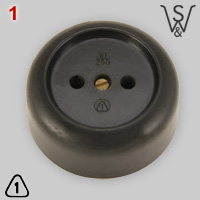 |
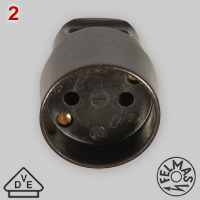 |
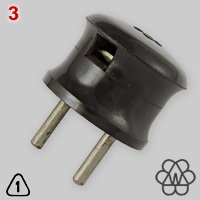 |
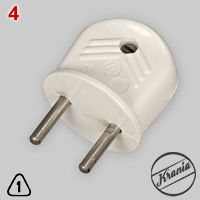 |
 |
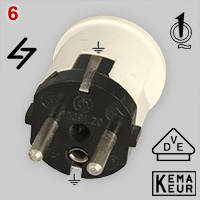 |
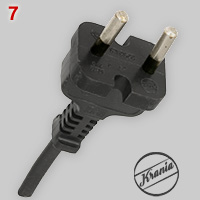 |
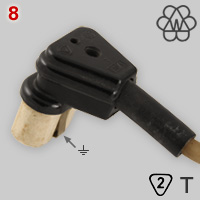 |
| 1 | Bakelite
2-pole
socket, rated at 10A-250V. The socket dates back to ca. 1960 and has a
grade 1 quality mark (see explanation below). The porcelain inner part
has a barely visible (unknown) manufacturer mark with capital letters W
and
S. {PM} |
| 2 | Bakelite
2-pole connector,
rated at 10A-250V. The outlet has a German VDE* certification mark and
MPAD molding mark**, but no DDR quality mark. The connector has been
made by Gustav Schortmann &
Sohn Fabrik Elektrotechnischer Spezial-artikel in Leipzig, who used the
trade name FELMAS. The
plugs must have been made in the late 1930s and is
therefore not a DDR product, but because of initial shortage of
material pre-WW II products remained in
use for a long time (see also plug no. 7). {PM} * VDE was founded in 1893 as Verband Deutscher Elektrotechniker; now a large testing and certification institute. ** Materialprüfungsamt zu Berlin Dahlem, an institute that from 1924 was involved in testing Bakelite products. The MPAD mark reveals that the Bakelite housing of the connector has been made by Robert Anke in Ölsnitz (Vogtland). Assembly and sales of plugs, connectors and sockets was done by Schortmann. |
| 3 | Plug rated at 6A-250V with a grade 1 quality mark. Just visible is a metal strip inside, being a part of the cord grip. Brand name: BEMA, used by Bergers Elektro-Mechanische Ausrüstungen GmbH in Beelitz (Brandenburg). {PM} |
| 4 | Grade 1 plug rated at 6A-250V. Manufacturer: VEB Elektroinstallation Kranichfeld in Kranichfeld, Thüringen. The DAMW molding mark indicate that the cast has been made of Aminopast, a melamine resin (code 152), reinforced with cellulose. {PM} |
| 5 | Plug rated
at
6A-250V without cord grip. Manufacturer: BEMA (see no. 3). The
collection
of DDR plugs comprises two copies of this model. One has a grade
2 quality mark, the other is grade 1. Apart from the mark, the to
plugs a fully identical. There are at least to possible explanations
for the difference in certification. It could be that it was initially
a mark 1 plug, but after designing plug no. 4 (with cord grip), the
model without cord grip was 'degraded' to level 2. But it is also
possible that the original model had a quality mark 2 and later
'upgraded' to level 1 when quality level 2 was abolished in 1970. {PM} |
| 6 note |
Schuko type of plug
with earthed clips commonly used in Germany from the 1930s, but using
the registered trade name Schuko was not allowed in the GDR. The shown
model was made by VEB für Installationen, Kabel und Apparate (IKA) in
Sondershausen in the 1980s (flash logo top left). Rating: 10-16A -
250V. It has features that point to an export product: (1) besides earth clips it has also a contact for sockets with an earth pin, although such sockets were not used in the GDR; (2) a 'Q1' top quality mark was too expensive for the home marked (see note), and (3) it has two non-GDR certification marks: VDE and KEMA certification marks. {PM} The museum has several nearly identical plugs, with and without additional contact for earth pins, that have quality grade 1 (triangle with 1). It is likely that those plugs were home market products. The upgrade to top quality was probably done for economic reasons (hard currency revenues) rather than technical improvements. Quality grade 1 plugs with earth pin contact could have been exported to Czechoslovakia and Poland. |
| 7 | Rubber plug with permanently fixed cord, rated with at 10-16A - 250V made by Krania in Kranichfeld, Thüringen.The model fits in not earthed sockets, but also in Schuko and French (CEE 7/5 ) socket. It is therefore to be regarded as a DDR version of the CEE 7/17 contour plug. Plugs have first of all designed to facilitate export of appliances to Czechoslovakia and Poland, countries that both have chosen for French type sockets. Certification marks suggest appliances with these plugs were also exported to Denmark, Sweden, Finland, Netherlands and Western Germany. {PM} |
| 8 | Grounded appliance connector of the same BEMA design as plug no. 5. Rated at 10A-250V and graded as quality level 2. The additional T mark indicates that the plug can resists temperatures above 60°C, because of the steatite plug tip. {PM} |
 |
 |
 |
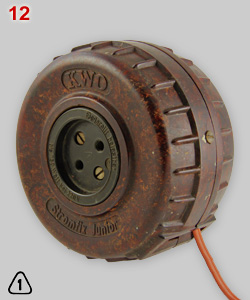 |
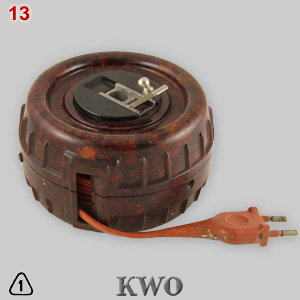 |
 |
| 9, 10 | Four-way
multi-outlet with original woven cotton cable, rated at 6A-250V. {PM} Click image 9 or 10 for additional examples and information |
| 11 | Extension cord with triple outlet, rated at 10A-250V. This tabletop model dates back to late 1960s. It has been made by the VEB Elektroinstallation Ruhla (ERU) in Ruhla, Thüringen. Later, ERU became a part of Kombinat VEB Keramische Werke Hermsdorf, a larger association of state owned enterprises. {PM} |
 |
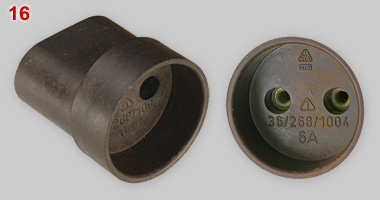 |
|
 |
|
| 15 - 17 | Adapter plug with 6.0 mm pins on one
side (image no. 15) and contacts for 4.0 mm pins on the other side
(image no. 16). Such adapters have been designed to couple a standard type, not earthed plug (image no. 17, right) to an appliance connector (black plug, left). Formerly separate extension cords with an appliance connector were used for irons, vacuum cleaners etc. The adapter enabled the use of extension cords also for other applications, for example (table) lamps. Dating: 1960s-'70s. Manufacturer of adapter: VEB Elektroinstallation Ruhla, in Ruhla, Thüringen. EIR was one of the companies that was allowed to use the trade name IKA (Installationen, Kabel und Apparate). Manufacturer of appliance connector: Scholz & Wenzel in Kleinschmalkalden, Thüringen. Manufacturer of white plug: Krania in Kranichfeld, Thüringen (also shown in image no. 4). Rating: 6A-250V for adapter and plug, 10A for appliance connector. Each has a grade 1 quality mark. {PM} |
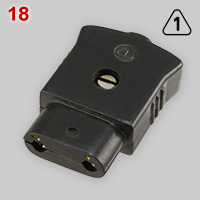 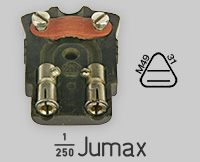 |
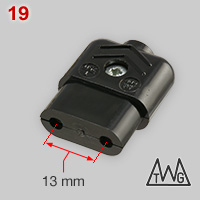  |
 |
 |
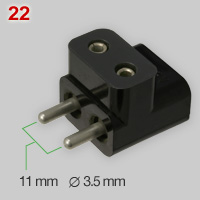 |
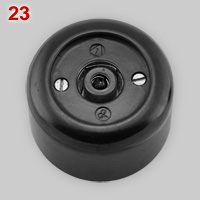 |
 |
| 18 | Connector
plug rated at 1A - 250V. It has a category 1 quality mark. Overall
dimensions in mm: 41 (length), 26 (width), 12 (height); contact zone:
11 x 21 x 9 mm. Contact diameter and spacing: identical to plug no. 19. DAMW molding mark: M49. Manufacturer: Jumax (company details unknown). {PM} It is likely that the plug has been designed for applications comparable to plug no. 19. See caption to image no. 20. for details. |
| 19 | 1A
- 250V connector plug made by VEB Thermometerwerk Geraberg (TWG),
probably in the 1950s - 60s. Wires have to be joined with solder. Image
no. 20 shows the use of the connector plug. {PM} |
| 20 | Example
of a mercury expansion thermometer with switch. Thin internal wires in
such thermometers make or break contact at an - adjustable -
temperature. A small 1A - 250V contact plug (see image no.
19) is used to connect thermometer to an appliance control unit (not
shown). The use of a plug with small pin contacts, close to each other has two advantages: (1) thermometers ask for small size plugs, and (2) it avoids potentially dangerous use of a standard mains plug. From the 1970s comparably small 42 Volt plugs were used. A 42V multi-plug is shown in image no, 22. Info: Peter Martin; photo: Ingo Marggraf. History of Thermometerwerk Geraberg (TWG). The company was founded in 1900 by Keiner, Schramm & Co. in Arlesberg*, near Ilmenau, Thüringen. Early 1950s TWG became part of Kombinat VEB Werk für Technisches Glas Ilmenau. The VEB splitt up in 1972 and renamed VEB Thermometerwerk Geraberg. In the GDR it was common practice that VEB's produced the full range of necessary components. This explains why connector plug 19 has a TWG logo. In 1990 the, now independent, company was renamed to Geratherm Medical AG. * neighboring villages Arlesberg and Gera fused in 1923 and became Geraberg. Manufacturers of thermometers and related glass instruments were the largest employers in Geraberg. |
| 21 | Connector
plug without any indication rating, origin and manufacturer. Because
the plug closely resembles plug no. 18, a rating of 1A - 250V is
likely. The Austrian donor of the plugs added a note that the connector
is said to be from a heated tea of coffee mug, and - if the assumption
is correct - it must be Chinese made. {MSt} |
| 42
Volt |
Low, "not dangerous" voltage local
circuits were used in the German
Democratic Republic (DDR), among others in wet rooms and at schools,
hospitals and laboratories*. Low voltage was initially defined at 24 to
42 Volt AC or 60 Volt DC. Later raised to 50V AC and 120V DC. Different types of plugs and sockets have been designed for low voltage applications to minimize the risks of connecting equipment in 220 Volt sockets. Examples of low voltage plugs and sockets are shown in images 24 - 26. * for example: The former Institut für Chemie der Hochschule in Karl-Marx-Stadt (now Institute of Chemistry of the Technical University of Chemnitz) had its own 42 Volt network that was used for equipment as microscopes, mixers, mercury switch thermometers etc. [info: Peter Martin]. |
| 22 | Two-way
multi-plug,
rated at 10A - 42V. Pin dimensions: diameter: 3.5 mm; length: 9 mm;
spacing 11 mm. {PM} |
| 23, 24 | Concentric
socket
and plug, rated at 10A - 42V. Socket: {PM}; plug {WN}. Marks, found on both socket and plug: top right: DAMW molding mark (L64/31, see below) and rating (10/42); bottom left: logo of manufacturer, Walter Bergers Elektro-Mechanische Ausrüstungen GmbH in Beeliz (apparently Berger has used two logos, see also plug no. 3); bottom right: quality mark. |
 |
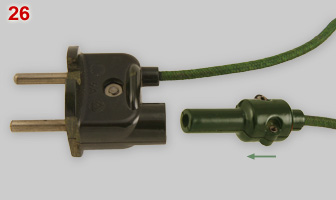 |
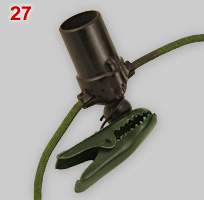 |
| 25 - 27 | Special
type of plug designed for a 16-lamp Christmas tree illumination set.
The
possibility to detach one of the connection makes it much more easy to
decorate a Christmas tree with a series of 16 light bulb sockets with
clip, connected to each other by a single wire. Note that the basal
part of the plug has been modified to allow the use in a
Schuko socket. The illumination set is a 1960s VEB
Elektroinstallation Oberlind* model, and has with an IKA plug**. {PM} * Oberlind is a part of Sonneberg, a small town in Thüringen, close to the border of Bayern. ** IKA: "Vereinigung Volkseigener Betriebe für Installationen, Kabel und Apparate" Leipzig. |
 Q = top quality
S = very good quality * 1 = good quality 2 = acceptable quality ** * : used until 1960, then S merged with Q ** : abolished in 1970 |
DDR Quality marks
(Gütezeichen der DDR) Quality marks for many products made in the German Democratic Republic (DDR) were introduced in 1950 by the German Organization for testing of materials and goods (Deutsches Amt für Material und Warenprüfung, DAMW), which in 1973 became the Organization for standards, measure and testing of materials (Amt für Standardisierung, Messwesen und Warenprüfung, ASMW). DAMW quality marks were established by Technical instructions on quality and terms of delivery (Technische Güte- und Lieferbedingungen, TGL), comparable to DIN standards. Three of four TGL quality marks - Q, 1 and 2 - have been found on DDR plugs and sockets shown on this page and/or the page on Classic Schuko plugs and sockets. The quality grading system was used to indicate which goods were suitable for export (or supply to the Military/Government agencies) and which were only for the domestic civilian market. Even the export grades were divided into suitable for export to "socialist" and "non-socialist" countries. Export to the latter was important to get hard currencies. Occasionally some export quality material was available for the home market, but they were more expensive than 'standard' domestic quality material. |
|
 |
DAMW Molding mark (Überwachungszeichen für Formmassen) Molding marks were used for casts made of phenoplast, aminoplast and comparable 'Duroplast' resins. The use the name Bakelite was not permitted in the DDR. Left / top code identifies the press work; often, but not necessarily, identical to the manufacturer of the plug or socket). L64 = Walter Berger, Mechanische Werkstätten, Beelitz. Right / bottom code indicates the resin used. No. 31 = phenolic resin, reinforced with sawdust filler (phenoplast). Designs 'b' and 'c' were most often used. Lists of DAMW codes for companies and types of resins can be downloaded as pfd's. |
| |
D i g i t a l M u s e u m o f | |
P l u g s a n d S o c k e t s | |
